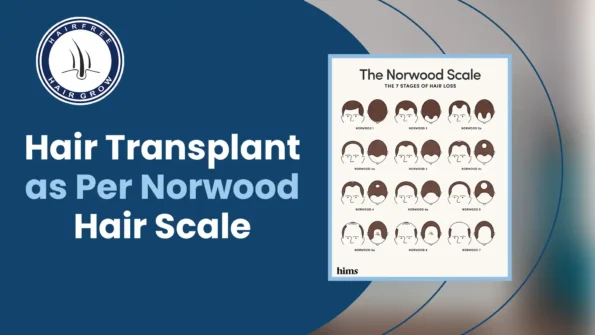Have you ever wondered why some people experience hair loss while others maintain a full head of hair throughout their lives? Hair loss, often associated with aging, can be distressing for many individuals. But understanding the Norwood Hair Scale can provide valuable insights into this common issue and help you make informed decisions about hair transplant procedures.
What is the Norwood Hair Scale?
The Norwood Scale, also known as the Hamilton-Norwood Scale, is like a map for understanding male-pattern baldness. It’s a tool that helps both doctors and people experiencing hair loss to understand how much hair has been lost and what stage of baldness someone might be in.
Each level represents a stage of hair loss, from no noticeable loss at all to almost total baldness. At the beginning of the scale, there’s stage 1, where there’s no obvious hair loss. Then, as you move up the scale, you see more and more hair loss until you reach stage 7, where only a horseshoe-shaped ring of hair remains around the sides of the head.
Male pattern baldness happens because of a hormone called DHT, which causes hair follicles to shrink over time. This shrinkage leads to thinner and shorter hair until eventually, the follicles stop producing hair altogether.
But it’s not just hormones that play a role. Things like age, genetics, and even hair color can affect how much hair someone might lose. Some people might be good candidates for hair transplants, where hair follicles from one part of the body are moved to the scalp to encourage new growth.
Decoding the Stages
- Stage 1: At this stage, there’s minimal to no hair loss. The hairline is intact, and there are no visible signs of balding.
- Stage 2: Hair loss becomes more noticeable around the temples, creating a slight recession in the hairline.
- Stage 3: The recession deepens further, forming a distinct “M” shape at the front of the scalp. This stage is often referred to as “mature hairline” or “temple recession.”
- Stage 4: Hair loss progresses to the crown of the head, creating a bald spot at the vertex while maintaining the receded hairline.
- Stage 5: The bald areas at the temples and crown begin to merge, leaving a horseshoe-shaped pattern of hair around the sides and back of the head.
- Stage 6: The remaining hair becomes thinner, and the bald areas expand, leaving only a band of hair across the top of the scalp.
- Stage 7: This final stage is characterized by extensive hair loss, with only a narrow band of hair remaining around the sides and back of the head.
How Much Hair Grafts Needed for Each Stage of Hair Loss
Norwood stage | Area of Scalp | Number of Grafts Front | Number of Grafts Crown |
|---|---|---|---|
1 | N/A | _ | _ |
2 | Front | 500-800 | _ |
2a | Centre | 500-1000 | _ |
3 | Front and temples | 1000-1500 | _ |
3a | Front and crown | Front: 1000-1500 | Crown: 500 – 1000 |
4 | Front and crown | Front: 1200 – 1600 | Crown: 800 – 1100 |
4a | Front | Front: 1700 – 2500 | _ |
5 | Front and crown | Front: 1800 – 2200 | Crown: 1000 – 1500 |
6+ | Front and crown | Front: 1800 – 2500 | Crown: 1500 – 1700 |
How Hair Transplants Can Help
Hair transplant surgery offers a long-term solution for hair loss, regardless of the stage on the Norwood Scale. During the procedure, hair follicles are harvested from donor areas (typically the back or sides of the head) and transplanted to the balding areas.
For individuals in the early stages of hair loss (Stages 1-3), a hair transplant can restore a natural-looking hairline and reverse temple recession. Those in more advanced stages may require multiple sessions to achieve desired results.
Choosing the Right Clinic
When it comes to hair transplant surgery, selecting the right clinic is paramount for achieving optimal results. With numerous options available, it’s essential to choose a clinic with a proven track record of excellence and patient satisfaction.
Among the multitude of options, HairFree HairGrow Clinic stands out as a leader in the field of hair restoration. why?
- With over 30 expert hair transplant surgeons and trichologists, HairFree HairGrow Clinic boasts a team of highly skilled professionals dedicated to providing top-notch care and outstanding results.
- With over 10 centers worldwide, including nine in India and one international center, HairFree HairGrow Clinic offers convenient access to quality hair transplant services wherever you are.
- With more than 10 years of experience and over 15,000 successful hair transplant surgeries performed, HairFree HairGrow Clinic has established itself as a trusted name in the industry.
- With a clientele exceeding one lakh satisfied individuals and over 5,500 successful surgeries in the last decade alone, HairFree HairGrow Clinic’s commitment to client satisfaction is evident.
- With over 3,540 positive reviews on platforms like Google, Facebook, and Trustpilot, and an impressive 97% of them rated five stars, HairFree HairGrow Clinic’s reputation speaks for itself.
Conclusion
Understanding the Norwood Hair Scale is key to addressing hair loss effectively. Whether you’re experiencing early signs of balding or have reached advanced stages, hair transplant surgery offers a viable solution to restore your confidence and youthful appearance. By consulting with a reputable surgeon and discussing your goals, you can embark on a journey towards a fuller, thicker head of hair.
Remember, you’re not alone in your struggle with hair loss, and modern advancements in hair restoration techniques have made it possible to achieve natural-looking results that last a lifetime.
Written By
MBBS, DDV
Dr. Nipun Kesarkar specializes in hair transplants according to the Norwood Hair Scale, offering customized solutions based on the patient’s specific stage of hair loss. His expertise ensures effective, natural-looking results for individuals seeking personalized hair restoration treatments.
Disclaimer
We’ve made all possible efforts to ensure that the information provided here is accurate, up-to-date and complete, however, it should not be treated as a substitute for professional medical advice, diagnosis or treatment. See Detailed Disclaimers Here.



